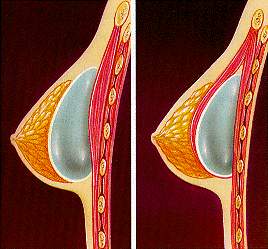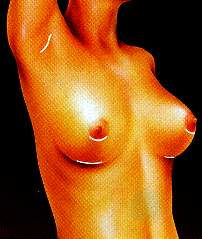The augmentation mammoplasty is a surgical procedure that takes place with the positioning of implants and that runs for several reasons.
- To increase the volume when a woman considers herself inadequate;
- To return to the lost volume after a pregnancy;
- To correct an imbalance between the two sides;
- To reconstruct a breast after a breast surgery.
The best candidates for a breast augmentation are those patients who wish to improve their physical appearance, with realistic perspective and not entrust the outcome too high expectations.
The implants are silicone shells filled with silicone in the form of gelatine or a normal saline solution.
It is important to point out correct informations about breast prostheses.
In 1992 the United States, following the complaint of a patient who reported to have developed breast cancer who believed have been caused through the involvement of prosthetic implants, the FDA (Federal Drug Administration American supervisory body) decided to suspend the use of prostheses awaiting concrete studies on the subject. A commission was set up to study and in the meantime the various countries around the world chose to follow the directions or not American directives.
In fact there were already several studies on this and all excluded correlations between the use of silicone implants and growth of tumours or development of autoimmune diseases, in fact Germany and the United Kingdom decided to not even take into account the American decisions. In Italy, instead, the Minister of Health applied the American provisions strictly and the media stressed and defunds news giving guilty and triggering panic among women. In 1995 the prosthesis were totally exonerate, but the news was not given with the same emphasis. For this reason I'll try to give some answers to those question that in the consultation I found to be the most frequently asked questions.
The silicone is a family of chemical compounds with many common uses. All of us every day we use perhaps without knowing it, objects containing silicone. The special characteristics of silicones make them ideal for many products, from equipment for use in surgery to creams for the hands or lipstick. Even some foods contain silicones. Silicones are produced from silicon, an element that is found in nature in the sand, quartz, in rocks. Besides oxygen, silicon is the most common element on the Earth's crust and, as for oxygen, and the animal life that depends on the silicon plant. Silicon becomes when silicone is combined with oxygen, carbon and hydrogen. Depending on how the molecules are arranged in silicon, silicon itself can be produced in various forms: powder, oils, gels and elastomers.
Silicones for their properties are widely used in products of mass consumption by about fifty years. For example, since in a specific formulation silicone can avoid the formation of foam, you can find as an ingredient in packaged puddings and cakes.
Many people regularly consume, in the formulation of simethicone, in some types of drinks and drugs antacids. The simethicone is also used in some medicines used in children, compared with abdominal colic. Another form of silicon, dimeticone, is commonly contained in various products for the care and hygiene of the body. In lipsticks, lip gloss and creams for the hands silicone acts as a protective moisturizing. Even the tanning creams, lotions against insects, shaving cream, aftershave, deodorant and shampoo, ointments and sprays for the hair contain some form of silicone.
The linen, clothing, handkerchiefs become soft to the touch after treatment with silicone. The silicone is also used as a water repellent for umbrellas, raincoats and protective wax.
These are just some examples of use of silicon in consumer products; are so many to be all mentioned.
The silicone has been used in medicine for about fifty years. No other material has proven to be bio-compatible, reliable, flexible, soft and easily sterilised as silicone. Silicones resist withstand any more chemical pushed as acid into the stomach. For these reasons, the silicon is the material most often chosen to build medical devices to be implanted inside the human body.
The silicone is used to be surgical needles and wires, the inside of syringes and vials for the preservation of blood or drugs by intravenous infusion, to be peace-makers and artificial heart valves.
The silicone elastomers are the bio-material preferred for a wide range of biomedical products. The "dummy" for infants is often made of silicone. The Norplant, new contraceptive, uses silicone tubes implantable in subcutaneous tissue for the gradual release of contraceptive drug in the body. Lenses silicone can restore sight to patients rendered nearly blind from cataracts. Exhaust silicone drainages can cure patients suffering from glaucoma or hydrocephalus. Silicone tubes are those that allow you to connect nefropatic patients the artificial kidney dialysis. In some patients with orthopedic problems are used in artificial silicon joints. In Plastic Surgery breast implants and tissue expanders allow reconstruction or improvement of some parts of the body.
The silicone materials have been studied extensively in research laboratory. These experimental data confirm that the materials of silicone do not cause cancer in humans. These studies are very important and provide basic evidence on product safety. However, clinical trials are even more reliable that directly control the effect of silicone in humans. Among these are the most important studies concerning women which were implanted breast implants for several years.
The breast cancers originate from duct cells and glandular epithelium and from here can spread throughout the body. In Italy, about one woman in ten (in the U.S. one in nine) can develop a breast cancer in his life. If the silicone increase the likelihood of getting sick of cancer, we should expect that women with breast implants were more likely to develop breast cancer. But it is not true. The outcome of clinical trials confirms that breast cancer is not more frequent in women with breast implants than it is in the other. A study conducted in Los Angeles at the University of Southern California in 1986 has examined over 3,000 women, which were implanted silicone breast implants for aesthetic between 1959 and 1980, results have shown that there is increased risk to develop breast cancer after the insertion of prostheses. Another study led to 'University of Calgary in Canada in 1992 has examined over 11,000 women whose implants were planted between 1973 and 1986, and here was also emphasised that there was no increased risk to develop breast cancer following the insertion of prostheses.
Yes you can, but since the prosthesis interferes, even minimally, in standard examinations must take an examination to multiple projections to radiologist. Your radiologist should be aware of current techniques location (such as the technique Eklund) to obtain projections of tissue surrounding the implants.
The intervention of additive mastoplasty is widely standardized, but like all interventions presents general and specific complications associated with it.
The most common complication is the specific capsular contracture. With the advent of the latest prosthetic devices, such eventuality occurs very rarely. There are varying degrees of contracture and in serious cases is an indication to a new surgery that can be weakening of the dish, or removal of the capsule itself and in some cases it may be necessary to make the change of the prosthetic.
Another complication that may occur, although in a very low percentage of patients, is to develop an infection around the prosthesis. Usually happens in the first post-operative (after 7-10 days). In the most important cases may be necessary to remove the prosthesis and wait some months before reposition a new plant.
The sensitivity of the complex aureole-nipple may increase, decrease or be almost absent. Such symptoms tend to resolve spontaneously in the space of a few months. In some cases it may take up to one year or more and rarely can be definitive.
Sometimes, though hardly happens, the prosthesis may rupture. The break is generally always due to an injury important. If the implants are saline solution, in the space of a few hours the affected breast is much smaller than the other. In case of prosthetic silicone gel is much more difficult to notice the break because the capsule generally dangerous does not allow the spreading of the gel in the short term (weeks or even months). The occurrence of unusual phenomena must lead the patient to go from specialist to perform diagnostic tests.
In a rupture of the implant, even if there is the character of urgency, you must undergo a review to remove the gel, clean up the pocket from residues and replace silicone breast implants.
It's a good practice, at the beginning of the previous week to not take Ac. Acetilsalicico (aspirin) to prevent coagulation problems, and for smokers to abstain for at least 4 weeks (two before and two after the operation).
If you have veterans from an infection or a disease it would be prudent to postpone the surgery.
If it is operated under the Day-Surgery (resignation the same day) is essential for the patient to be accompanied by a person who can take care of bring him/her home during the first 24-48 hours. A patient returned from a pregnancy, will have to wait at least 9 months after the end of breastfeeding.
The method of inserting prosthesis and the kind of approach depend on the patient. The incision can be placed in the wake sub-breast, around cable. By working through this incision creates a pocket above or below muscle and ranks the plant.
If the patient has a little glandular tissue that does not guarantee a good coverage of prostheses is preferable chosing sub-muscular position. The latter is slightly more painful than sub-ghaindolare, but it becomes especially clear when tension is put into the large pectoral muscle, a slight movement of prosthetic outwards to the chest.


Drainage can be used in certain cases and removed a few days after the procedure.
The intervention takes about 1 hour and the incisions are closed without external suture points to improve its final appearance. A particular bandage is maintained for the first 48 hours.
The intervention can be conducted both in General Anaesthesia in local anaesthesia and possible sedation according to the wishes of the patient.
After the first medication the patient will wear a bra conformed for 4 weeks. The first two day and night, the latest 2 only during the day.
The post-operative pain is well controlled and generally tends to disappear after 24-48 hours.
The immediate post-operative breast seem even greater than it has in reality for the important oedema (swelling) present, which tend to decline gradually during the week. At least 6 days will be necessary to wait to see the new breast under normal conditions and at least three months must wait first to hear sufficiently soft.
The return to normal activity is fast enough. It's a good practice, however, wait at least one week to recover gradually and stop for at least four practicing sport.
The breast will be pained and is therefore advisable to avoid direct contact for a few weeks.
If the patient remains pregnant there are no problems for a possible feeding because no technique provides for the interruption of goods and functionally gland remains intact.
If the expectations are realistic patient satisfaction for the intervention is very high.
However I must stress that:
ONLY THE SINGLE AND NATURAL BREAST IS NATURAL.
A BREAST NATURAL DO NOT CONTAIN A PROSTHETICS MAMMARIA.
IF YOU WANT A BREAST COMPLETELY NATURAL NOT MAKE A ADDITIVE MASTOPLASTY
The additive mastoplasty can change the appearance and restore the lost self-confidence, but not necessarily change the look according to the desires or change the way to make people around us.